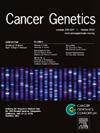4.实体瘤宏基因组事件检测技术的临床应用
IF 1.4
4区 医学
Q4 GENETICS & HEREDITY
引用次数: 0
摘要
宏基因组事件(MGE)是大型基因组改变,它们共同构成了复杂的全基因组突变或结构特征。它们包括非整倍体、结构变异、拷贝数变化、拷贝中性杂合性缺失区域、突变特征、同源重组缺陷和微卫星不稳定性。虽然有几种现有的和新兴的 MGE 检测技术,但系统评估其在实体瘤检测中的实用性的工作还很有限。因此,我们成立了 CGC MGE 工作组,以总结在多种分辨率下检测实体瘤 MGE 的各种技术的优势和局限性,评估目前临床使用的技术,并对较新检测方法的临床实施可行性进行评估。正在考虑的技术包括全基因组测序(短读和长读)、光学基因组图谱、芯片(染色体和甲基化)、核型分析、靶向测序技术(即 Sanger、ddPCR、qPCR、靶向测序面板)、FISH 和 Hi-C。通过查阅文献和当地实验室规程,我们确定了 15 项数据采集标准,并根据这些标准对每项检测进行评估,包括样本要求(如新鲜冷冻组织与福尔马林固定石蜡包埋组织)、断点精确度和检测到的 MGE 类型。虽然这项工作仍在进行中,但初步研究结果表明,虽然 "完美 "的检测菜单可能并不存在,但检测的共同适应症和现有的实验室基础设施可能有助于确定检测的优先顺序。此外,我们的研究小组还发现了实体瘤检测的几个障碍(如肿瘤百分比要求、断点精度要求、RNA 与 DNA 检测),以便在评估整体临床效用时加以考虑。本文章由计算机程序翻译,如有差异,请以英文原文为准。
4. The clinical implementation of technologies utilized for macrogenomic event detection in solid tumors
Macrogenomic events (MGE) are large genomic alterations that together contribute to complex, genome-wide mutational or structural signatures. These include aneuploidy, structural variants, changes in copy number, regions of copy neutral loss of heterozygosity, mutation signatures, homologous recombination deficiency, and microsatellite instability. Although there are several existing and emerging technologies for the detection of MGE, limited work has been done to systematically assess their utility within solid tumor testing. Thus, we formed the CGC MGE Working Group to summarize the strengths and limitations of various technologies for solid tumor MGE detection at multiple resolutions, to evaluate those in current clinical use, and to provide an assessment of feasibility of clinical implementation for newer assays. Technologies under consideration are whole genome sequencing (short- and long-read), optical genome mapping, microarray (chromosomal and methylation), karyotyping, targeted sequencing technologies (i.e., Sanger, ddPCR, qPCR, targeted sequencing panels), FISH, and Hi-C. Through a review of the literature and local laboratory protocols, we defined 15 data capture criteria by which each of these tests are being assessed, ranging from sample requirements (e.g., fresh-frozen versus formalin-fixed paraffin embedded tissue), to breakpoint precision and the types of MGE detected. Although this effort is ongoing, preliminary findings suggest that while a 'perfect' test menu may not exist, common indications for testing and existing laboratory infrastructure may help determine test prioritization. In addition, our group identified several barriers to solid tumor testing (e.g., percent tumor requirements, precision of breakpoints required, RNA vs DNA-based testing) to consider when assessing overall clinical utility.
求助全文
通过发布文献求助,成功后即可免费获取论文全文。
去求助
来源期刊

Cancer Genetics
ONCOLOGY-GENETICS & HEREDITY
CiteScore
3.20
自引率
5.30%
发文量
167
审稿时长
27 days
期刊介绍:
The aim of Cancer Genetics is to publish high quality scientific papers on the cellular, genetic and molecular aspects of cancer, including cancer predisposition and clinical diagnostic applications. Specific areas of interest include descriptions of new chromosomal, molecular or epigenetic alterations in benign and malignant diseases; novel laboratory approaches for identification and characterization of chromosomal rearrangements or genomic alterations in cancer cells; correlation of genetic changes with pathology and clinical presentation; and the molecular genetics of cancer predisposition. To reach a basic science and clinical multidisciplinary audience, we welcome original full-length articles, reviews, meeting summaries, brief reports, and letters to the editor.
 求助内容:
求助内容: 应助结果提醒方式:
应助结果提醒方式:


